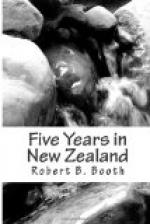CHAPTER III.
LYTTELTON AND CHRISTCHURCH.—CALL
ON OUR FRIENDS.—VISIT
MALVERN HILL.
Port Lyttelton at the time was but an insignificant town in comparison with what it has since become, although from its confined situation it is unlikely ever to attain to any great size. It is the port of the capital of the province, Christchurch, from which it is separated by a chain of hills. A rough and somewhat dangerous cart road led from it to the capital, along and around the hill side, which was twelve miles in length, but there was also a bridle track direct across the hills, by which the distance was reduced by one-half. This path, however, could be used only by pedestrians, or on horseback with difficulty. In 1862 it was decided to connect the port with Christchurch by a railway, cutting a tunnel through the hill, and the project was completed in 1866. In 1859 Port Lyttelton was built entirely of wood, the houses being for the most part single-storeyed. There was a main street running parallel to the beach, with two or three branch streets, running up the hill therefrom; there were a few shops, several stores, stables, and small inns. The harbour was an open roadstead, and possessed but a primitive sort of quay or landing place for boats and vessels of small tonnage.
We were invited on shore by the Leach’s sheep-farming cousin, who had come to meet them, but we returned on board to sleep. The following morning, getting our luggage together, we all four started for Christchurch on hired horses, sending our kit round the hill by cart. The climb up the bridle path (we had to lead the horses) was a stiff pull for fellows just out of a three months’ voyage, but we were repaid on reaching the top by the magnificent panorama opened out before us. To our right was the open ocean, blue and calm, dotted with a few white sails; to the left the long low range of hills encircling the bay, and on a pinnacle of which we stood. At our feet lay Christchurch, with its few well-laid-out streets and white houses, young farms, fences, trees, gardens, and all the numerous signs of a prosperous and thriving young colony, the little river Avon winding its peaceful way to the sea and encircling the infant town like a silver cord, and the muddy Heathcote with its few white sails and heavily-laden barges. While beyond stretched away for sixty miles the splendid Canterbury Plains bounded in their turn by the southern Alps with their towering snow-capped peaks and glaciers sparkling in the sun; the patches of black pine forest lying sombre and dark against the mountain sides, in contrast with the purple, blue, and gray of the receding gorges, changing, smiling, or frowning as clouds or sunshine passed over them. All this heightened by the extremely rare atmosphere of New Zealand, in which every detail stood out at even that distance clear and distinct, made up a picture which for beauty and grandeur can rarely be equalled in the world.




